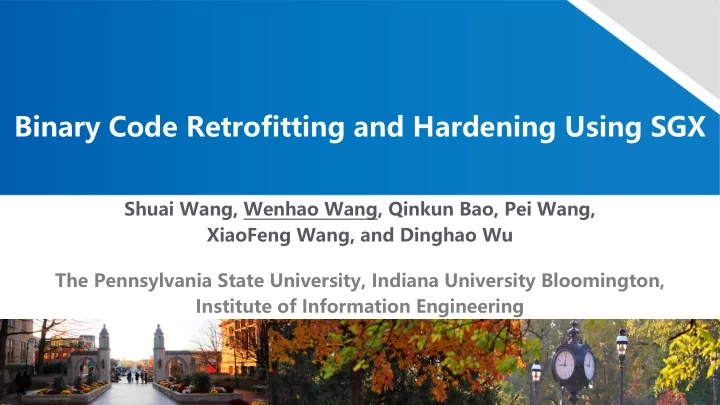

Binary Code Retrofitting and Hardening Using SGX Shuai Wang, Wenhao Wang, Qinkun Bao, Pei Wang, XiaoFeng Wang, and Dinghao Wu The Pennsylvania State University, Indiana University Bloomington, Institute of Information Engineering
Motivation Available in Intel Commercial CPUs Hardware isolated memory regions Protection under a strong adversary model A bit performance penalty (~10%)
Motivation Available in Intel Commercial CPUs Hardware isolated memory regions Protection under a strong adversary model A bit performance penalty Can binary code hardening benefit from SGX?
Motivation Graphene-SGX, Haven Large TCB (53 kloc for Graphene-SGX)
Motivation Graphene-SGX, Haven Large TCB (53 kloc for Graphene-SGX) Our solution Techniques to dissect binary code into multiple components Put into separated enclaves
Background on SGX Two capabilities address mapping change in enclave memory access Processor semantics Reserved Memory (PRM) protection of the ELRANGE Enclave Page address mappings of Cache (EPC) the application
Background on SGX Life cycle Enclave Initialization (ECREATE/EINIT) EENTER ERESUME non-enclave enclave mode mode AEX EEXIT Enclave Destroy (EREMOVE)
Background on SGX Life cycle Enclave Initialization (ECREATE/EINIT) EENTER ERESUME non-enclave enclave mode mode AEX EEXIT Enclave Destroy (EREMOVE)
Background on SGX Controlled enclave entry Separated stack CPU state and registers are cleared if exceptions occur inside the enclaves.
Methodology
Methodology OCALL ECALL ECALL Interface library: maintain routine code for ecall and ocall
Methodology OCALL ECALL ECALL In-place binary editing: Trampoline code
Challenges Binary code reassembly disassembling Uroboros How to generate enclave libraries Intel SGX SDK Binary instrumentation to jump to the enclave entry Trampoline code Exceptions Customized exception handling inside the enclaves
Challenges Binary code reassembly disassembling Uroboros How to generate enclave libraries Intel SGX SDK Binary instrumentation to jump to the enclave entry Trampoline code Exceptions Customized exception handling inside the enclaves
Some technique details In-place binary editing Trampoline code
Some technique details Exceptions Customized exception handling inside the enclaves
Proof-of-concept implementation Extend Uroboros with SGX instrumentation functionalities. Employ the core functionality of Uroboros to identify program relocation symbols (e.g., code pointers). Use industrial standard reverse engineering tool (IDA-Pro) to recover the function type information. Implement the instrumentation functionality in Scala, with over 1,700 LOC. The proof-of-concept implementation of the exception handling mechanism adds 56 lines of C code.
Evaluation Evaluations mainly focus on understanding the feasibility and cost of the instrumentation products. Two major factors would contribute to the performance penalty of the SGX protected code: Execution slowdown of code components inside enclaves. Cross-enclave control flow transfers, e.g., enclave ECALL.
Evaluation Setup Our preliminary evaluation instruments sensitive procedures provided by cryptographic libraries . AES implementation in OpenSSL (version 0.9.7) Write sample code to trigger the encryption and decryption functions in the library. key length is set as 256. AES electronic codebook (ECB) mode.
Evaluation Setup To measure the performance cost of code within enclave (first factor): • All encryption/decryption computations are performed within one enclave. • Pointers on key and data blocks are passed in through the interface.
Evaluation Setup To measure the impact of inter-enclave control flow transfers (second factor): • Put the block-level encryption/decryption functions into the enclave. • Control the number of inter-enclave control transfers by changing the length of the input data.
Evaluation Results 4 × overhead over computation without SGX when processing over 100k data blocks, overhead is 6.91%.
Evaluation Results We measure the size increase in terms of multiple components: • Size of output binary is identical with the input, since we perform in- place binary instrumentation. • Both SDK routines and our routine code introduce size increase. • The overall size increase is within a reasonable extent. • Evaluation One has three more functions than Evaluation Two .
Future works Limitations How to reliably recover the function prototype? How to deal with the shared variables among several isolated enclaves? Some instructions/operations may not be supported inside the enclaves. …
Thanks! Contact: ww31@indiana.edu
Recommend
More recommend